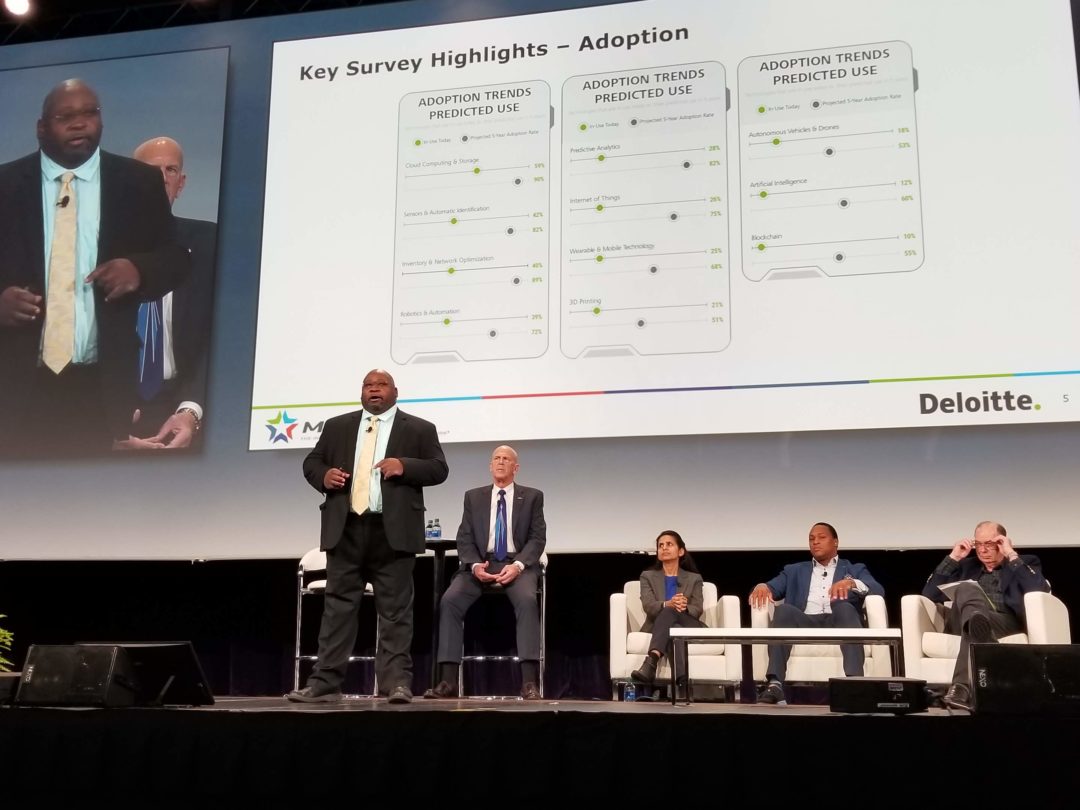Modex 2020: Findings of MHI’s Annual Industry Report discussed at Wednesday morning keynote

MODEX show sponsor MHI released its 2020 edition of the Annual Industry Report during Wednesday morning’s keynote. (Printed copies are available in booth 4071.) Developed in conjunction with Deloitte Consulting for the seventh consecutive year, the findings of “Embracing the Digital Mindset: Connecting Data Talent and Technology in Digital Supply Chains” were discussed by a panel including:
- George Prest, CEO of MHI
- Thomas Boykin, a leader of Deloitte Consulting’s Supply Chain Network Optimization practice and lead researcher of the MHI Annual Industry Report
- Arpana Brahmbhatt, U.S. Industry Solutions – Manufacturing for Microsoft
- Randy V. Bradley, Assistant Professor of Information Systems and Supply Chain Management, Haslam College of Business, The University of Tennessee
- Rick Faulk, CEO of Locus Robotics
After a brief introduction from Prest highlighting respondent demographics, Boykin overviewed the key findings of the survey. Notably, 80 percent of respondents said that the digital supply chain will be the industry’s dominant model within the next five years, “and 20 percent say it’s the dominant model right now,” Boykin said.
As with previous reports, this year’s survey queried participants on current and anticipated adoption rates and investment in 11 different digital technologies:
- 3D Printing
- Artificial Intelligence (AI)
- Blockchain
- Cloud Computing & Storage
- Driverless Vehicles & Drones
- Internet of Things (IoT)
- Inventory & Network Optimization
- Predictive Analytics
- Robotics & Automation
- Sensors & Automatic Identification
- Wearable & Mobile Technology
“The digital technology most used currently by 59 percent of respondents is cloud computing and storage; 90 percent say they will adopt it within five years,” noted Boykin. “Robotics and automation are currently in use by 39 percent, with 68 percent saying they will adopt those technologies within one to two years, and 72 percent planning to adopt them in the next five years. Additionally, while only 28 percent currently use predictive analytics, 82 percent say they will be doing so in five years.”
In terms of the degree of expected impact of each of the technologies, the biggest jump was in robotics and automation, he continued. “Last year it was fifth place in terms of its potential for disruption or to create a competitive advantage; this year it jumped to first from 67 percent of respondents.”
As for investment in digital technologies over the next 24 months, 50 percent plan to invest up to $1 million; 25 percent plan to spend up to $5 million; and five percent will invest $50 million or more. “Investment in digital supply chain technologies is increasing and fairly heavy,” commented Boykin.
Supply chain challenges keeping leaders up at night have not changed much over the past seven years. “The high competition for talent remains the biggest challenge, with 57 percent saying their organization struggles to hire and retain qualified workers,” he continued. “That’s followed by rising customer expectations for faster, better, and cheaper service.”
Among the solutions to the talent shortage, 55 percent of companies say they are either reskilling their existing workforce or promoting from within. Another 48 percent have implemented job training and mentoring programs; and 46 percent are partnering with educational institutions to identify and cultivate potential candidates.
“Data and technology are what’s driving and will empower the supply chain of the future, but no single technology alone will do that. It will take a combination of the 11 highlighted technologies in the report—but talent is the key,” said Boykin.
In keeping with the theme of the report, the panelists discussed multiple ways that data, technology, and talent can be connected to address these supply chain challenges.
New in this year’s report, a follow-on to last year’s Supply Chain Digital Consciousness Index—a self-assessment offered to companies to help them measure the level of digital mindset within their operation (dormant, developing, heightened, or elevated) across five key digital capabilities: leadership, talent, customer engagement, workforce environment, and innovation/technology. This year companies can leverage a toolkit to help them develop an action plan for their digital supply chain journey. First step is to take the survey to identify where a company is along that maturity curve.
“The toolkit allows you to develop a tactical action plan in terms of where you are to where you’d like to be. We encourage everyone to seek that out and take that self-assessment,” said Boykin.
Related Articles
Copyright ©2024. All Rights ReservedDesign, CMS, Hosting & Web Development :: ePublishing